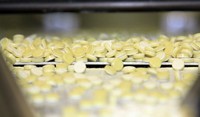Advertisement
Grab your lab coat. Let's get started
Welcome!
Welcome!
Create an account below to get 6 C&EN articles per month, receive newsletters and more - all free.
It seems this is your first time logging in online. Please enter the following information to continue.
As an ACS member you automatically get access to this site. All we need is few more details to create your reading experience.
Not you? Sign in with a different account.
Not you? Sign in with a different account.
ERROR 1
ERROR 1
ERROR 2
ERROR 2
ERROR 2
ERROR 2
ERROR 2
Password and Confirm password must match.
If you have an ACS member number, please enter it here so we can link this account to your membership. (optional)
ERROR 2
ACS values your privacy. By submitting your information, you are gaining access to C&EN and subscribing to our weekly newsletter. We use the information you provide to make your reading experience better, and we will never sell your data to third party members.
ACS News
Open House
Fine chemicals producers respond enthusiastically to an invitation from Novartis
by Rick Mullin
November 8, 2010
| A version of this story appeared in
Volume 88, Issue 45
Contact between drug companies and their suppliers of active pharmaceutical ingredients (APIs) has been dominated for decades by an institutionalized cycle of conferences, exhibitions, and dinner events. The list of annual meetings seems to grow every year, along with the monotony of having to attend. But everybody puts up with it in order to do business and to keep current with industry gossip and goings-on.
There was, however, an unexpected buzz of excitement at CPhI, the big European trade show for pharmaceutical ingredients, held in Paris last month. It had to do with another event, a suppliers’ day meeting sponsored by Novartis a week earlier. Executives at CPhI and the European Fine Chemicals Group’s annual dinner, held at the Paris Westin Hotel, agreed that Novartis appears to have opened up a new line of communication with its API suppliers.
The buyer-seller relationship is ripe for change in the pharmaceutical chemical industry, given how drug companies are trying to improve efficiencies both in the laboratory and at the manufacturing plant. Most are significantly scaling back internal API production and increasing their outsourcing. Supplier partnerships that key on technology innovation to improve manufacturing processes—lowering costs by more than simply cutting prices—ought to be the order of the day.
Nevertheless, such partnerships haven’t yet fully evolved in the drug industry, according to Christopher Game, Novartis’ head of technical operations sourcing. Game, who hosted “Link,” the Novartis suppliers’ day meeting, has some perspective on the evolution of partnerships, given that his previous jobs were with automakers BMW and Toyota, companies in an industry viewed as a leader in procurement strategies.
“The word ‘partner’ is probably the most abused term when referring to suppliers in the pharmaceutical industry,” Game tells C&EN. “Everybody’s your partner. Everybody’s preferred. But it’s really superficial compared to what a partnership would represent in aviation or in automotive. I’m trying to turn that around.”
As is often the case with agents of change, Game has a view that contradicts the status quo. Although most contract producers will tell you they are marching to the tune of their big customers, Game says drug companies need to wrest control of the contracting process from their suppliers—in particular, he says, from the suppliers holding court in the Waldorf Astoria Hotel in New York City during DCAT Week, the annual week of meetings and events clustered around the Drug, Chemical & Associated Technologies Association’s black-tie dinner at the hotel.
“At DCAT, the suppliers take a suite of rooms and have their customers in for short, sharp meetings that set the pace for the year ahead,” Game says. “They have their business development discussions on their own turf with predetermined outcomes.”
The pharmaceutical industry is running about 15 to 20 years behind the automotive sector on contract negotiations, Game says. He describes the old auto industry style as “taking a supplier into a dark room and beating him with a stick: The supplier feigns defeat, gives you a few percent off, and goes away with a big grin on his face, and we are all happy for another year.”
Drug companies need to end a similar charade, he says, by initiating real discussion of their needs with key suppliers. In turn, those suppliers, he says, need to base their offering on newly gained insight into their customers’ plans for drug development and manufacturing. But the relationship must reflect the realities of the pharmaceutical industry. Game notes that much more basic innovation is needed in drug-making than in automobile manufacture, where changes are generally tweaks to existing technology. Drugmakers need breakthroughs in the lab and at the plant, and their chemical suppliers require room to innovate in order to assist.
Game says Novartis used the Link event to introduce a regime of teamwork with suppliers. The company has inaugurated technology such as Internet portals, setting the goal of replacing “the old buddy system” with an open scheme of incentives that, for example, raise the payment on a project on the basis of quality improvements—or lower payments on the basis of quality shortfalls.
More important, Novartis wants to get suppliers involved in process research. “We want to get their development folks to own the product into the commercial cycle, so that they maintain responsibility postlaunch,” he says. “This will help them make better decisions early on and will help us manage the life cycle better.”
There have been carrots as well as sticks in the dance between drugmaker and contract supplier for years. Drug companies—notably Merck & Co.—have routinely held suppliers’ day events. But the executives at CPhI say they recognized a fundamental change at the Novartis event, which was attended by about 60 companies. They saw an openness in communication and a willingness to listen—a hint, perhaps, of the kind of exchange that may emerge as drug companies pursue sustainable cost reductions in association with innovation in R&D.
“Novartis has taken a real step forward,” the head of a German contract manufacturing business told C&EN during CPhI. “Game, who’s coming from the auto industry, has opened up in a valuable way about the company’s real needs.”
The German executive spoke on the condition that he not be named in an article because he does not want his company identified as a supplier to Novartis. Well, we can’t expect too much change all at once.
Views expressed on this page are those of the author and not necessarily those of ACS.






Join the conversation
Contact the reporter
Submit a Letter to the Editor for publication
Engage with us on Twitter